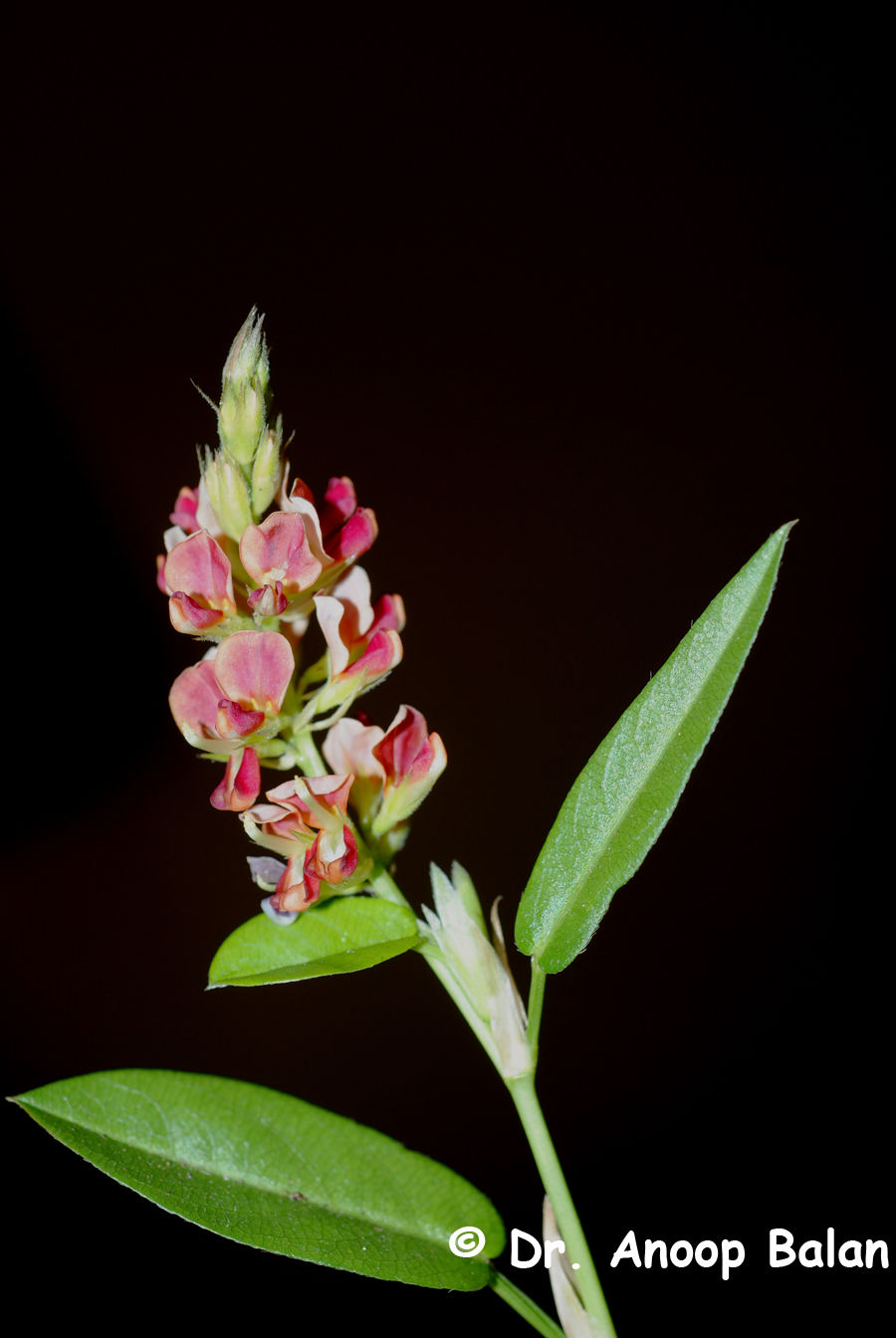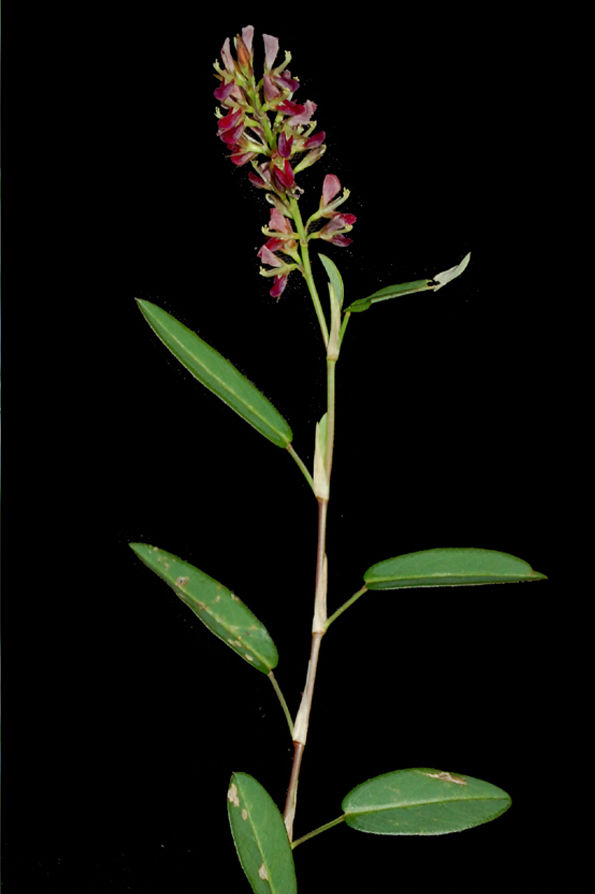Dovepea
alysicarpus vaginalis
Also known as: ["Dovepea","Cowpea Clover"]
Overview
Alysicarpus vaginalis is a herbaceous plant in the legume family, known for its small yellow flowers and trifoliate leaves.
Benefits & Perks
["wildlife attractant (bees, butterflies, birds)","drought tolerant"]
Botanical Classification
| Phylum: | Magnoliophyta |
| Class: | Magnoliopsida |
| Order: | Fabales |
| Family: | Fabaceae |
| Genus: | Alysicarpus |
| Botanical Name: | Alysicarpus vaginalis |
Plant Characteristics
Basic Information
- Category: Herbs & Weeds
- Suitable Location: open garden beds in tropical or subtropical regions
- Suitable For:
- Is Weed: No
- Allergenicity: low
Environmental Needs
- Climate: {"temperatureRange":"10–35°C"}
- Hardiness: {"zones":"8–11"}
- Misting: rarely required, only if ambient humidity is very low
- Drainage: Fast-draining to prevent waterlogging.
- Soil Type: Well-draining, loamy soil with organic matter; can tolerate sandy soils.
Maintenance Level
- Maintenance Level: low
- Toughness Level: moderate
- Pruning Frequency: Annually in late winter or early spring; light pruning can be done as needed.
- Pruning Intensity: Moderate; remove up to one-third of growth if overgrown.
Care Details
Ideal Sunlight Coverage:
Full sun to partial shade (4–6 hours of direct sunlight daily); tolerates some shade in hot climates.
Sunlight Tolerance Tips:
Acclimate gradually to intense sunlight; protect from harsh afternoon sun; adjust placement based on seasonal light changes.
Care Requirements
Care Difficulty
easymoderate
Sunlight
full sun to partial shade
Rotate plant for even growth; use sheer curtains in intense sun; move outdoors in spring/summer.
Watering
every 7–10 days during active growth, reduce in winter
Water thoroughly but infrequently; ensure proper drainage; adjust based on season and growth stage.
Soil
well-draining, sandy loam with moderate organic content
pH: Slightly acidic to neutral (pH 6.0–7.0).
Avoid heavy clay soils; ensure pots have drainage holes; amend with organic matter.
Temperature
Thrives in warm conditions (65–85°F or 18–29°C); tolerates mild frosts but prefers stable warmth.
Protect from frost; avoid sudden temperature swings; maintain consistent warmth.
Fertilizing
every 4–6 weeks during growing season
Fertilize sparingly; flush soil occasionally to prevent salt buildup; stop in dormant periods.
Propagation
Methods
Stem cuttings or division; stem cuttings are more common for home growers.
Step-by-Step Propagation Guide
- Take 4–6 inch cuttings.
- Remove lower leaves.
- Plant in moist medium.
- Keep warm and humid.
Best Time: Spring or early summer when the plant is actively growing.
Environment
Warm, humid environment with indirect light; maintain consistent moisture.
Medium
Well-draining potting mix with perlite or sand; can root in water initially.
Hormone
Optional but recommended for faster rooting.
Timeline
Roots develop in 2–4 weeks; new growth appears in 6–8 weeks.
Tools Needed
Pruning shears, rooting hormone, small pots, misting spray bottle.
Quick Tips
Use healthy, non-flowering stems; maintain high humidity; avoid direct sun during rooting.
Pruning & Repotting
Pruning Guide
Method
Pinch back tips for bushiness; cut stems just above a leaf node.
Pruning Plan
Prune to maintain shape, encourage bushiness, and remove dead or overgrown stems.
Tools
Clean pruning shears or scissors, gloves.
Checklist
Sanitize tools; prune dead/damaged stems; shape as desired; dispose of clippings.
Repotting Guide
Best Season
Spring, before the active growing season begins.
Pot Size
Choose a pot 1–2 inches larger in diameter than the current one.
Method
Remove plant gently; trim roots if needed; place in fresh soil with good drainage.
Suggestions
Repot every 2–3 years or when roots fill the pot; beneficial for growth and soil freshness.
Checklist
Prepare new pot with drainage holes; trim roots if crowded; use fresh soil mix.
Advanced Care Tips
Watering Mastery
Watering Checklist
Check soil moisture; water deeply; ensure drainage; adjust for season.
How to Apply Water Properly
Water at the base of the plant, ensuring moisture reaches the root zone; avoid wetting foliage; allow excess water to drain away.
Watering Schedule Tips
Water deeply once the top inch of soil feels dry; reduce frequency in winter to prevent root rot.
Soil Improvement
Add perlite or sand for drainage; incorporate compost for fertility; ensure good aeration.
Temperature Stress Management
Signs of Temperature Issues
Wilting, yellowing leaves, or stunted growth in extreme heat or cold.
Cold Stress
Slows growth, may cause leaf drop; vulnerable to frost damage in prolonged cold.
Solution: Move to a warmer location; provide frost protection; avoid overwatering in cold.
Hot Stress
Leaf scorch, wilting, or reduced flowering in excessive heat.
Solution: Provide shade during peak heat; increase humidity; water more frequently but avoid waterlogging.
Fertilizing Guide
Fertilizing Checklist
Use diluted fertilizer; apply during active growth; avoid winter feeding.
Fertilizing Method
Use balanced liquid fertilizer diluted to half strength every 4–6 weeks during growing season (spring/summer); avoid fertilizing in winter.
Common Problems & Solutions
Toxicity Warning
Cats
Non-toxicAlysicarpus vaginalis is not known to be toxic to cats. It does not pose a significant risk if ingested.
⚡ Toxic If:
if eaten
Dogs
Non-toxicAlysicarpus vaginalis is not known to be toxic to dogs. It does not pose a significant risk if ingested.
⚡ Toxic If:
if eaten
Humans
Non-toxicAlysicarpus vaginalis is not known to exhibit toxic effects in humans. It is generally considered safe for consumption.
⚡ Toxic If:
if eaten
Frequently Asked Questions
Q: Is Alysicarpus vaginalis toxic to pets?
A: There is insufficient data on its toxicity to pets.
Q: How often should I water Alysicarpus vaginalis?
A: Water moderately, allowing the soil to dry between waterings.
Q: Does Alysicarpus vaginalis attract wildlife?
A: Yes, it attracts bees, butterflies, and birds due to its flowers.
Quick Reference
| Family: | Fabaceae |
| Care: | easy |
| Light: | full sun to partial shade |
| Water: | every 7–10 days during activ |
Get Expert Care Tips
Download the Plantious app for personalized care reminders and plant identification!
Google Play App Store








